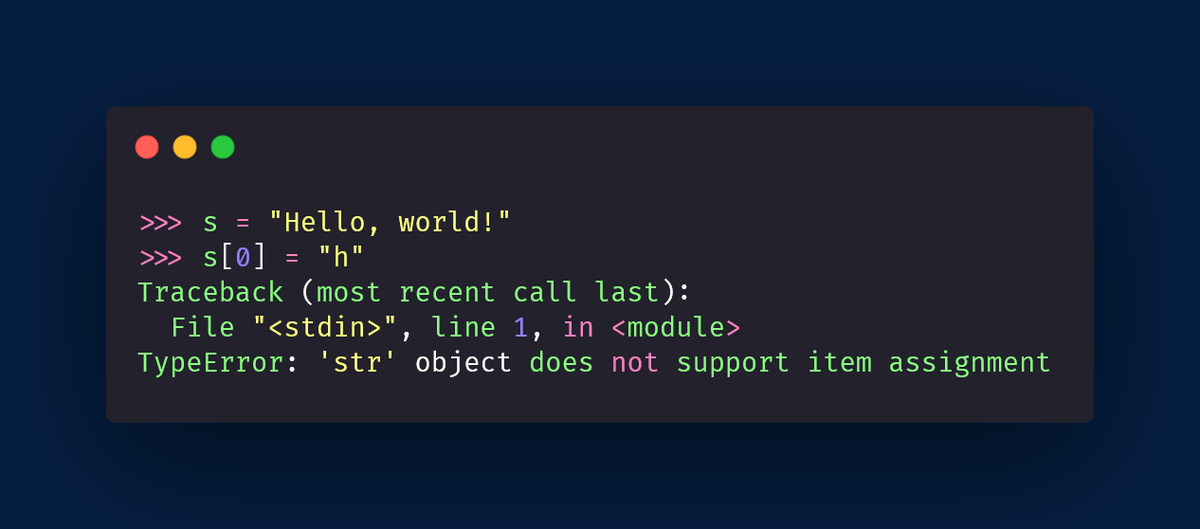
I enjoy thinking about multiple possible solutions to the same Python 🐍 problems.
I do!
Call me crazy 🤪, I don't care!
In the past, I've tweeted simple challenges 🏆, you tweeted solutions, and I wrote a thread analysing your solutions.
Here is a meta 🧵 of past challenges!
I do!
Call me crazy 🤪, I don't care!
In the past, I've tweeted simple challenges 🏆, you tweeted solutions, and I wrote a thread analysing your solutions.
Here is a meta 🧵 of past challenges!
The first challenge I ever posted was to implement the Caesar cipher
https://twitter.com/mathsppblog/status/1424878368760242183
This is the thread with the solutions 👇
The moral of the story was that very little people know about the `str.maketrans` and `str.translate` methods.
The moral of the story was that very little people know about the `str.maketrans` and `str.translate` methods.
https://twitter.com/mathsppblog/status/1425492527868694528
Then I wrote about implementing something like a `.find` method on lists.
Something that looks for the index of an element, but doesn't throw an error when the element is not there.
Here's the thread 👇
Something that looks for the index of an element, but doesn't throw an error when the element is not there.
Here's the thread 👇
https://twitter.com/mathsppblog/status/1420791368335695872
The next one I published had a more math-y vibe to it.
Or at least, it was implicit there.
I wanted you to compute the sum of the first positive integers:
Or at least, it was implicit there.
I wanted you to compute the sum of the first positive integers:
https://twitter.com/mathsppblog/status/1426965708714487812
The best solution made use of a mathematical insight, allowing us to write a closed formula!
Way better than the “obvious” O(n) solution summing along a range, or similar 👇
Way better than the “obvious” O(n) solution summing along a range, or similar 👇
https://twitter.com/mathsppblog/status/1427256481796218880
Next up is the last.
No, no, not the last challenge I published!
A challenge to implement a “last” function.
(I'm so funny :P)
No, no, not the last challenge I published!
A challenge to implement a “last” function.
(I'm so funny :P)
https://twitter.com/mathsppblog/status/1428857011920384002
That was a great one because lots of people chipped in with amazing ideas!
You can read those ideas here 👇
You can read those ideas here 👇
https://twitter.com/mathsppblog/status/1429803103642132493
After that one, I posted a challenge about checking if a string is a pangram.
I had been doing some research on Python sets and wanted to see if you'd put them to good use!
I had been doing some research on Python sets and wanted to see if you'd put them to good use!
https://twitter.com/mathsppblog/status/1431980960858480651
Of course you didn't disappoint, and many of you presented lovely alternatives making use of `set`:
https://twitter.com/mathsppblog/status/1432672442212831232
After a challenge that dealt with strings, I wrote a challenge about numbers.
I asked you to implement the `sign` function.
It's such a simple function...
I asked you to implement the `sign` function.
It's such a simple function...
https://twitter.com/mathsppblog/status/1442042804398665732
And yet, this was the challenge that generated more fuss, with people coming up with all sorts of crazy ideas!
I think I did a pretty good job of exploring them in the solution thread 👇
I think I did a pretty good job of exploring them in the solution thread 👇
https://twitter.com/mathsppblog/status/1443138696220487681
I stayed on the maths side of things, and came up with the idea to ask you to implement the `sum` function, that is a Python built-in:
https://twitter.com/mathsppblog/status/1453026230568108041
The solution thread I wrote took some effort, but ended up looking nice 👇
https://twitter.com/mathsppblog/status/1454336729427726337
Then, I actually enjoyed asking you to implement a built-in, so I did it again!
This time, I asked you to implement `enumerate`, to see how you'd handle the fact that you needed to return an iterator:
This time, I asked you to implement `enumerate`, to see how you'd handle the fact that you needed to return an iterator:
https://twitter.com/mathsppblog/status/1454753646097408000
... and *once again*, you didn't disappoint!
Many awesome solutions were sent to me, so I had a lot of material to work with for the thread I wrote comparing all the alternative approaches 👇
Many awesome solutions were sent to me, so I had a lot of material to work with for the thread I wrote comparing all the alternative approaches 👇
https://twitter.com/mathsppblog/status/1455444589603557378
I can't help it, I have a mathematical background, and thus I asked you for a maths-inclined function again, which also played with iterables:
The `argmax` function 👇
The `argmax` function 👇
https://twitter.com/mathsppblog/status/1455982863816474627
The solution thread was a fair amount of work to put together, but we covered all sorts of interesting concepts...
Like the fact that `max` takes an optional `key` argument, or that indexing has an equivalent in the `operator` module:
Like the fact that `max` takes an optional `key` argument, or that indexing has an equivalent in the `operator` module:
https://twitter.com/mathsppblog/status/1456659427302330375
Lastly, I published another string-based challenge, where I wanted you to swap the casing of the input string!
I am yet to write the solution thread for this challenge, but I have **not** forgotten 👇
I am yet to write the solution thread for this challenge, but I have **not** forgotten 👇
https://twitter.com/mathsppblog/status/1458350716301426688
These are the problems/solutions I've written on Twitter.
If you like this content of mine, then you'll love to know that I'll be launching a Problem-Solving Bootcamp tomorrow!
Part of it will have a similar feel to these threads!
I'll explain briefly:
If you like this content of mine, then you'll love to know that I'll be launching a Problem-Solving Bootcamp tomorrow!
Part of it will have a similar feel to these threads!
I'll explain briefly:
You'll be solving some practice problems, and then I'll send you an in-depth analysis of multiple solutions for you to study!
It's going to be great!
You can find out more about it here:
It's going to be great!
You can find out more about it here:
https://twitter.com/mathsppblog/status/1463882694455185412
• • •
Missing some Tweet in this thread? You can try to
force a refresh














